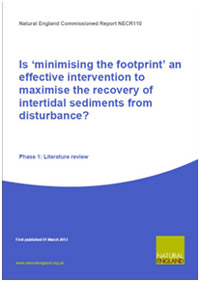Website: www.sednet.org
Compiled by: Marjan Euser (marjan.euser@deltares.nl)
Subscription Service: SedNet Secretariat (marjan.euser@deltares.nl)
Disclaimer: SedNet is not responsible for faults due to incorrectness of info in this newsletter.
Previous issues: www.sednet.org/newsletter
CONTENTS
8th International SedNet conference
Lisbon, Portugal, 6-9 November 2013
Hosted and co-organised by LNEC
“Innovative Sediment Management: How to do more with less”
The preliminary conference program is almost ready and will soon be uploaded on the conference-webpage on www.sednet.org.
| The conference program will consist of key-note presentations and parallellecture sessions on | |
| ● | Sediments and ecosystems (and their services) |
| ● | Integrated sediment management |
| ● | Sustainable dredged material management |
| ● | Sediment quality and quantity issues |
| ● | Interaction between fluvial, estuarine and coastal sediment |
| Further there are Special Sessions: | |
| ● | ECSA Special Session: Changing hydrodynamics of estuaries and tidal river systems |
| ● | ARCH Special Session: Management of multiple pressures on estuaries and lagoons in a changing climate |
| ● | Relationships between sediment and biota in transitional water ecosystems and harbours |
| ● | Mechanics of sediment transport (see also the “Call for abstracts”, next item of this newsletter) |
Working Groups
A new item in the conference program is the starting up of Working Groups.
Thursday 7 November afternoon will provide opportunity for new initiatives – brought forward by the network – on sediment research and management. These Working Group meetings may focus on any topic in the field of sediment research and sediment management. Any conference participant who would like to brainstorm with his fellow-sediment-specialists will be given the possibility to organise such a Working Group meeting. Those meetings are open for any conference participant to join and thus contribute to the discussion. The outcome of these Working Group meetings will be presented briefly in the plenary session at the end of the conference.
The most promising Working Group initiatives may get some support from SedNet to kick-off the execution of activities that they propose.
If you have questions about this initiative or wish to reserve time and a meeting room for a Working Group during the conference, please contact the SedNet Secretariat.
A Working Group that has registered already and will meet on 7 November is:
| Working Group: Strengthening the connection between science and policy for improved sediment managementThe Water Framework Directive and Marine Strategy Framework Directive provide opportunities for improved sediment management. Although these opportunities are still not generally seized, both frameworks will probably become the context for sediment management in future. Both directives are characterized by a systemic approach that will ask for integration of scientific knowledge from different disciplines, for stakeholder involvement and appreciation of local knowledge, and for integrated policies (e.g. spatial management) in new governance arrangements instead of sectoral policies that are still mainstream nowadays. The interface between science and policy is extremely important for the development of sediment management within these frameworks as it should provide the evidence base for the interventions and new management opportunities (governance approaches). Instruments for an improved connection between science and policy have been developed in several EU-projects. A goal of this session is to find out if there is interest in the SedNet-community to start a specific SedNet Working Group on science-policy interfacing for sediments and – if yes – to draft a proposal for that Working Group. |
During the conference posters will be exposed. A special Poster Session is held on 6 November at the end of the day.
Conference fee and registration
A registration form can soon be found on www.sednet.org
The conference fee is 400 euro (for students 100 euro) excluding VAT.
Upon registration participants will receive an invoice for the conference fee.
Exhibition
A number of display spaces is available to institutions, administrations and companies interested in presenting themselves or their products to the conference participants. Companies that are interested in participating in the exhibition can contact the organising secretarial staff at LNEC: Mr José Anacleto – e-mail sednetlisbon@lnec.pt – for information, subscription and payment. Costs for exhibiting are 1230 Euro inclusive of VAT. Deadline for subscription to the exhibition is 11 October 2013.
Contact: SedNet Secretariat: marjan.euser@deltares.nl
Call for Abstracts for the Special Session on Mechanics of Sediment Transport
on 7 November 2013
(during the SedNet conference in Lisbon)
Appropriate management of sediments in estuarine and fluvial environments can only be achieved if suitable physically-based theoretical tools are available for end-users. Fundamental research on sediment transport, ranging from grain-scale to intermediate scales, provides adequate closures to modeling large-scale fluvial and estuarine processes. Solutions for problems related to morphological evolution of mobile beds, water quality, restoration works, flood protection measures and ecological equilibrium can thus be given adequate responses.
This Special Session aims at complementally gather researchers working on fundamental issues of sediment transport and researchers and end-users tackling engineering-scaled processes. Prolific discussions, focused on bridging the gaps in engineering knowledge on sediment transport as well as on the experience of modelers in incorporating new theories ensuing from fundamental research in their models, are expected.
Researchers working on mechanics of sediment transport in oceans, rivers or reservoir environments are invited to participate in this special session. Submitted themes may include grain-scale mechanics of sediment transport, river and estuarine morphology, suspended load, cohesive sediments, interaction with turbulence, interaction with structures or ecological considerations. Research relying on experimental methods and instrumentation such as PIV, LDV and acoustic velocimetry as well as numerical work on data production with LES/DNS/SPH and on CFD numerical solutions for engineering-scale problems are especially welcome.
The session is organized by:
Mário J. Franca, École Polytechnique Fédérale de Lausanne, Lausanne, Switzerland
Rui M.L. Ferreira, CEHIDRO, Instituto Superior Técnico – TULisbon, Lisbon, Portugal
Abstract submission
Abstracts shall be submitted directly to the organizers of the session (see contacts below), no later than 1st September 2013.
The template available in SedNet Conference 2013 website should be used.
Contacts
Mário J. Franca: mario.franca@epfl.ch
Rui M.L. Ferreira: ruif@civil.ist.utl.pt
New member SedNet Steering Group
The SedNet Steering Group is pleased to inform that the Swiss Centre for Applied Ecotoxicology EAWAG/EPFL (Ecotox Centre) joined the SedNet Steering Group. Carmen Casado, scientist in sediment ecotoxicology, will represent the Ecotox Centre in the SG.
The Ecotox Centre develops practice-oriented research, education and training, and services for authorities and third parties whenever expert knowledge is needed. It is also involved in numerous application-oriented scientific projects on ecotoxicological assessment, risk assessment and the development and optimisation of test methods, mostly in collaboration with external partners from authorities, Cantonal bodies and industry. The Ecotox Centre has its headquarters at EAWAG, the aquatic research institute within the ETH (Federal Institutes of Technology) domain in Dübendorf, Switzerland. The second branch, which specialises in terrestrial and sediment ecotoxicology, is located at EPFL in Lausanne.

Carmen Casado, Ecotox Centre
The Ecotox Centre develops practice-oriented research, education and training, and services for authorities and third parties whenever expert knowledge is needed. It is also involved in numerous application-oriented scientific projects on ecotoxicological assessment, risk assessment and the development and optimisation of test methods, mostly in collaboration with external partners from authorities, Cantonal bodies and industry. The Ecotox Centre has its headquarters at EAWAG, the aquatic research institute within the ETH (Federal Institutes of Technology) domain in Dübendorf, Switzerland. The second branch, which specialises in terrestrial and sediment ecotoxicology, is located at EPFL in Lausanne.
As SedNet, the Ecotox Centre aims at incorporating sediment issues and knowledge to support the achievement of a good environmental status and to develop new tools for sediment management. The Ecotox Centre is keen to participate in the exchange of experiences and knowledge through SedNet and to contribute to the dissemination of good practices and success stories on sediment quality and quantity issues at a pan-European level.
SedNet Symposium “Understanding sediment processes at catchment scale”, Koblenz, Germany, June 2013
SedNet has organised a one day symposium at the 6th IAHS International Conference on Water Resources and Environmental Research: Water and Environmental Dynamics, which has run from 3-7 June 2013 in Koblenz, Germany. The SedNet symposium was on “Understanding sediment processes at catchment scale” and was convened by Peter Heininger (Federal Institute of Hydrology, Germany), Sue White (Cranfield University, UK), Susanne Heise (HAW Hamburg, Germany), and Ivana Teodorovich (University of Novi Sad, Serbia).
The focus of the 6th conference was set on fostering an integrative understanding of water and the environment, bringing together scientists from the fields of hydrology, environmental research, aquatic ecosystem research, water resources research and management as well as global change to discuss solutions for transient environmental boundary conditions. The SedNet symposium addressed sediment processes at the catchment scale, tackling sediment sources and transfer pathways, monitoring programmes, and sediment management.
Eleven abstracts were selected for presentation at the SedNet symposium, covering a large number of fundamental issues in environmental sciences and hydraulics. Contributions addressed the methods and strategies for measuring sediment transport processes including large databases such as those from watersheds in Ontario Canada or Austrian rivers, sediment transport modelling, calibration and validation, and how results from different approaches can be used for improved management of local watersheds. On the quality side, contributions addressed the evaluation of pollution sources and the mobilisation and transport of sediment bound contaminants at the catchment scale with case studies on traditional contaminants including metals, polychlorinated biphenyls, but also acid mine drainage, hazardous substances released from water construction materials, and radioactive substances strongly attached to suspended sediment such as cesium-137. Case studies from Europe, Africa, America and Asia ensured a broad geographic coverage.
Four other sessions on the Analysis and modelling of sediment transfer in Mediterranean landscapes, Modern hydraulics structures for better hydrodynamics and hydromorphology of streams and rivers, Climate change and freshwater sediments and Climate change impacts on coastal waters and sediments also included contributions on methodological improvements and case studies on natural and anthropogenic modulation of sediment transport processes.
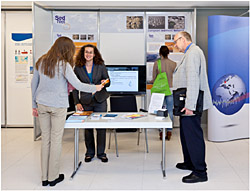
SedNet at the exhibition of the 6th IAHS International Conference on Water Resources and Environmental Research: Water and Environmental Dynamics
The outcome of the conference will be published as a cluster of peer reviewed papers by Springer in the book “Sediment matters: the challenges”. The book, edited by Dr. Peter Heininger (Federal Institute of Hydrology) and Dr. Johannes Cullmann (IHP/HWRP Secretariat) aims at presenting scientific progress in process and system understanding and management as well as sound foundations for policy development.
Further information on www.water-environment.org
GeDSeT, a Decision Support Tool for innovative management scenarios for sediments from waterways
A decision support tool on the management of sediments from waterways was developed by the Belgian-French GeDSeT project (InterReg IV, 2008-2013; SedNet course, Ferrara 2012). This tool was built using literature reviews, new research results and extensive exchanges with the actors and stakeholders of sediment management.
The tool belongs to the family of multicriteria DSTs (Laboudigue et al., 2011; Michel et al., 2012) and is based on a “what-if” strategy, rather than offering the “best possible option”. Therefore, it allows to test innovative scenarios and to support discussions with local authorities and communities. Scenarios evaluated with enlarged system boundaries allow to identify external benefits, such as pollution mitigation, reduced minerals extraction or land use, improvement of fluvial transport or living conditions.
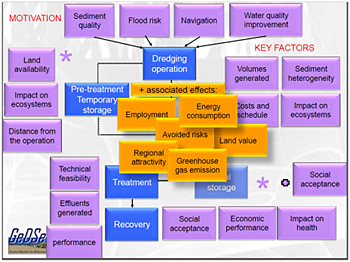
Fig. 1: Data and indicators for the GeDSeT tool.
Examples of innovative scenarios will be discussed at the SedNet conference in Lisbon (Lemière et al., submitted). They comprise:
Scenario 1: selective dredging
Selectively dredge first the most contaminated hotspots, then bulk dredge the remainder of sediments from the waterway section. Consequences: a) reduction of the contaminated volume to be treated or sent to hazardous waste disposal, b) reduction of the average contamination of bulk dredged sediments, c) selection of less contaminated sediment lots, acceptable for reuse.
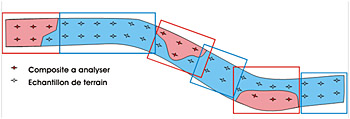
Fig. 2: Selective dredging and detail characterisation.
Crosses: sampling points. Boxes: contour of composites currently used for lab characterisation for bulk dredging. Field characterisation of individual samples would allow selective dredging of hotspots (pink) and subsequent valorisation of less contaminated sediment (blue).
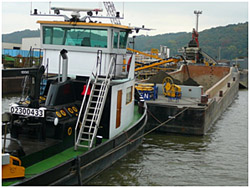
Fig. 3: Mobile sediment treatment plant
Scenario 2: on-site treatment
Process as much as posssible the sediment with a ship-borne plant. On-site dehydration allows to obtain easier output material. Consequences:
a) reduction of the dredged volume to be managed or sent to valorisation,
b) water can be returned to the waterway after treatment.
Scenario 3: selective treatment
Sediment loads are directed towards a treatment procedure adequate for their pollutant contents (inorganic and/or organic). This scenario is applicable to sediment treatment facilities currently developed near canals. Treatment may be aimed at reducing contamination under critical levels for less polluted sediments, or at concentrating the pollutants in a low volume fraction for safe disposal. Reusable sediment loads may be shipped to reuse sites.

Fig.4: Selective processing of dredged sediment loads (left) in canal-side treatment plant: uncontaminated, direct shipping to reuse site; low contamination: dehydration or landfarming until reuse (1); medium contamination: treatment and separation (2); high contamination: concentration and disposal as hazardous waste (3).
Scenario 4: alternative use of sediment
Selectively dredged or treated sediments may be directed to reuse according to contamination level and regulatory constraints. Potential uses comprise: a) bulk use where applicable (landfill cover, civil works, excavation backfill), b) composite use (mix with concrete demolition aggregate), c) use as an alternative mineral resource (cement production). Benefits include the reduction of primary minerals extraction and of sediment storage, hence increase of possible waterways dredging operations.
Scenario 5: alternative use of disposal sites
Sediment deposits are highly vegetated due to abundant organic matter, but they are unfit for food crops. Their use for energy crops (wood pellets, seeds) would reduce undesirable land use and allow energy crops on fertile soil without competition for land with food crops.
References
Laboudigue, A., et al., 2011. The GeDSeT Project: coupling multi-criteria analysis and knowledge improvement on sediment for a close-to-the-field Decision Support Tool. 7th International SedNet conference, Venice.
Michel,. P et al., 2012. The GeDSeT project: constitution of a decision support tool (DST) for the management and material recovery of waterways sediments in Belgium and Northern France. WASCON, Göteborg,www.swedgeo.se/wascon2012.
Authors
Bruno Lemière (BRGM), Pascale Michel (BRGM), Claire Alary (Ecole des Mines), Laurence Haouche (ISSeP), Hervé Bréquel (CTP), Jérôme Jacob (BRGM), Nathalie Gineys (CTP), Agnès Laboudigue (Ecole des Mines)
Contact: Bruno Lemière, BRGM, B.Lemiere@brgm.fr
The development of a decision support tool on sediment management led to the identification of several innovative management scenarios (ref: article GeDSeT above). Most of these scenarios require that data on the contamination level can be obtained in real time on the dredging site or at the unloading point before reuse.
Research led during the GeDSeT project showed that this can be achieved for most of the inorganic substances using portable X-ray fluorescence spectrometry on site, without waiting for laboratory analyses, provided that a simple dehydration procedure is applied (Lemière et al., in press).
For the main organic contaminants (petrol hydrocarbons, PAHs and PCBs) this is not yet possible, but the feasibility study led in the GeDSeT project allows to undertake the same approach in a daughter project (CEAMaS, 2013-2015).
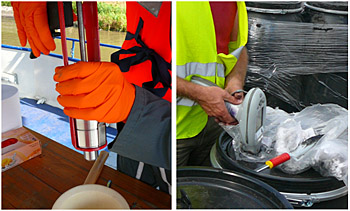
Fig. 1: On-site sample preparation (left) and pXRF analysis (right)
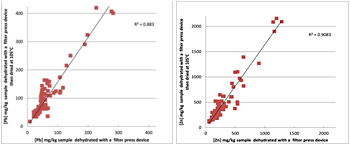
Fig.2: comparison between on-site (X-axis) and off-site (Y-axis) measurements for Pb (left) and Zn (right)
Reference
Lemière, B., Laperche, V., Haouche, L., & Auger, P, in press. Portable XRF and wet materials: application to dredged contaminated sediments from waterways. Geochemistry: Exploration, Environment, Analysis.
Authors
Bruno Lemière (BRGM), Valerie Laperche (BRGM), Laurence Haouche (ISSeP), Pascal Auger (BRGM)
Contact: Bruno Lemière, BRGM, B.Lemiere@brgm.fr
Is ‘minimising the footprint’ an effective intervention to maximise the recovery of intertidal sediments from disturbance?
Phase 1: Literature review (NECR110)
Activity on intertidal soft sediments can cause damage or disturbance of the habitat from abrasion, penetration and removal. For example, vehicles used to reach cockle beds for fishing or access to structures such as piers for maintenance works.
Natural England’s advice in these situations has been based around sensitivities of habitats assessed on the MarLIN website. Generally, the advice has been that developers and developments should minimise the scale and extent, of the impact within the environment. This approach of ‘minimising the footprint’ generally leads to a more intense disturbance over a relatively smaller area. Recent anecdotal evidence suggests that recovery is quicker, and more complete, if the disturbance covers a wider area, but at a lower intensity.
This work was commissioned to review existing information on recovery of intertidal soft sediment habitats from different levels and intensities of disturbance.
Setting scientific principles for sediment risk assessment
From the newsletter of ECHA – the European Chemicals Agency
How to use science for regulatory purposes was one of the key questions tackled at ECHA’s first topical scientific workshop, held on 7-8 May 2013, which covered sediment risk assessment. The workshop brought together over 100 experts from around the world to set the scientific principles for assessing risks to the sediment compartment in all regulatory contexts.
“There have been significant developments in science concerning sediment risk assessment, which are not reflected in the current guidance,” says ECHA’s Jose Tarazona, the workshop Chair. He says that the workshop conclusions provide a good basis for reviewing the current guidance.
“Our aim was to set basic principles that could be applied in all regulatory contexts. After all, the science is the same for predictive risk assessment conducted for example for substances under REACH, and for retrospective site-specific assessments conducted on contaminated areas, for example under the Water Framework Directive. Depending on a specific regulation, the tools and methods may vary, but should be based on shared scientific grounds.”
The two-day workshop included general plenary sessions with case studies and topical breakout group sessions, where the participants discussed specific recommendations on how to use scientific knowledge for regulatory purposes.
“There were, for example, recommendations on when to trigger the risk assessment for the sediment compartment, what should be the basic principles and how to use the equilibrium partitioning method(*) for screening purposes. The participants also gave their ideas for covering the exposure assessment, predicting the concentration levels expected in the environment and reaching the sediment organisms, and elaborated on the tools that are available for describing and predicting the effects,” says Dr Tarazona.
Another conclusion from the workshop was that the risks for sediment should be considered as part of the aquatic assessment and should not be restricted to invertebrates. “The current guidance focuses only on sediment invertebrates. Obviously, the invertebrates are very relevant but there are other taxonomic groups and ecological functions that need to be considered as well,” Dr Tarazona points out.
This conclusion might mean that simply updating the guidance is not enough – a new conceptual model needs to be developed to make sure that the risks are covered for all relevant substances.
(*)The equilibrium partitioning method (EqP-method) can be used for adapting the REACH information requirements on soil and sediment testing. To derive screening environmental quality standards for soil or sediment, it uses aquatic toxicity data and a soil/water or sediment/water partitioning coefficient.
Further information
Setting scientific principles for sediment risk assessment
Workshop programme, presentations, list of participants, background material and case studies
Note by SedNet: Dr Tarazona will give a key-note presentation at the SedNet conference in Lisbon on 7 November 2013.
How can we generate more public and political attention for sediment and soil management?
The AquaConSoil conference was held in Barcelona 15-19 April 2013. At this event the Dutch Deltares institute together with the Flemish MOW, OVAM, LNE and VMM organized a special session entitled “The potential for further integration of soil, sediment and water management and how ecosystem services may help”. In the session the highlights were presented of the 2012 Flanders ‘sediment day’, i.e. present the state-of-art on integrated management of soil, sediment and water in Flanders. Thereafter ample time was used for discussion with the session participants. One of the key-questions discussed was “How can we generate more public as well as political attention for sediment-soil-water management”. One of the outcomes was that it might help to jointly (the more critical mass, the better) prepare a ‘White Paper’. This paper should describe in a language understandable for policy makers what the many positive contributions are of sediment-soil-water ecosystem services to key issues that ARE being perceived as important/urgent by the public and politicians, i.e. jobs, energy, safety and health (see figure).
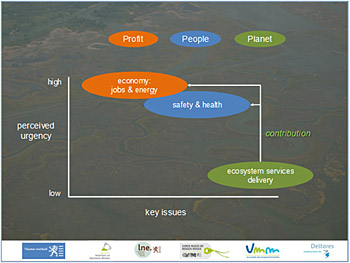
The feasibility of preparing such a white paper is now being explored. A nice response/quote already from Paul Nathanail (Cabernet): “Perhaps a White Paper that seeks to place soil and sediment in the resource category rather than as a hazard or something that is being threatened may make policy makers rethink.”
For more information contact Jos Brils (Deltares): jos.brils@deltares.nl
NATO proposal for part II sediment training course Sava river basin
In the SedNet eNewsletter of November 2012 you have already been informed on the successful outcome of the 1st part of the “practical training course on sustainable sediment management with the Sava river basin as showcase” (see also: www.savacommission.org). SedNet – in close cooperation with the International Sava River Basin Commission (ISRBC) and UNESCO Venice office – submitted a proposal to NATO (Science for Peace and Security programme) for funding the 2nd part of this course. Part II of the course will focus on measures and governance aspects. The outcome of the proposal review is expected by December this year. If the proposal is granted by NATO, than we anticipate part II of the course to be held in March 2014.
Contact: Jos Brils, Deltares: jos.brils@deltares.nl
WODCON XX – World Dredging Congress “The Art of Dredging”, 3-7 June 2013, Brussels
The 20th anniversary World Dredging Congress and Exhibition, WODCON, took place in Brussels from 3rd to 7th of June. This event takes place every three years in the European, American or Asian section of the World Organisation of Dredging Associations (WODA) and is the premier dredging event for professionals from around the globe. This year’s theme “The Art of Dredging” addressed skills, craft and experience to be brought together to an intended achievement. Cees van Rhee, chairman of the technical paper committee, explained the link of dredging to art by stating that famous artist Leonardo da Vinci already designed dredging equipment in his time, combining science and art which was seen as the same discipline in those days.
In total a number of 95 technical papers were presented by delegates from all continents, covering all aspects of dredging and marine construction. They were organized in parallel sessions, one about dredging equipment and the dredging process, the other focusing on management of sediments, environmental dredging as well as sediment assessment and monitoring.
A special session was dedicated to “The dredging debate” steered by CEDA environment commission chairman Polite Laboyrie. A panel with representatives from CEDA, EADA, WEDA and PIANC got the audience to discuss about themes covering aspects of Working with Nature, Adaptive Management as well as Stakeholder Involvement. Additionally a CEDA position paper on underwater sound as well as an information paper on ecosystem services and their relevance to the dredging industry were presented.
Another special double-session was committed to dredging works in the Westerschelde. To one part the focus was on the navigation channel and the applied dredging strategy, the hydro- und morphodynamic developments and the impact of human intervention. The further part of the session focused on recent developments in the Port of Antwerp and its new treatment facility for dredged material as well as dealing with siltation rates in the new tidal Deurganckdok through construction of a new current deflection wall.
The technical tours took the WODCON visitors to travel along the Schelde and learn about the Sigma Plan for flood protection. Further a visit to the AMORAS treatment facility and the construction site of the new lock within the Deurganckdok were offered.
| WODCON XX: Best Paper Award for research on long-term and far-field dispersion of finesThe best paper award was granted to Thijs van Kessel (Deltares) for his paper with co-author Bas van Maren (also Deltares) on the far-field and long-term dispersion of released dredged material. In the paper the cumulative effect of a large number of sediment plumes on turbidity levels is analyzed. Although the dispersion of individual plumes is often considered for impact assessments, it is the cumulative effect of a large number of individual plumes that determines the impact on the long term. Resuspension from the seabed may become the dominant factor contributing to turbidity. The contribution of dredged material to the natural background turbidity depends on the type and amount of material added to the system relative to type and amount of fine sediment already present due to natural processes. The proposed methodology is applicable in systems in with a low natural percentage of fines in the bed. In this case the addition of fines (e.g. by dredging operations) is likely to increase turbidity levels as more fines become available for resuspension and transport. The paper presents examples of computations on the far-field and long-term dispersion of fines in the natural environment and their sensitivity to parameter settings such as settling velocity, critical shear stress for erosion and burial rate. More informatie: Thijs van Kessel |
With a total of about 430 registered visitors, WODCON XX was a very successful event, especially the exhibition was the perfect place for international  networking. All technical presentations will be made available to the public, please check the Conference website for details.
networking. All technical presentations will be made available to the public, please check the Conference website for details.
Karlsruher Flussgebietstage 2013 („River Basin days 2013“), 20-21 June 2013, Karlsruhe, Germany
The “Karlsruher Flussgebietstage” is a biannual international symposium held at the Institute of Water and River Basin Management (IWG) of KIT. The symposium is a platform for the scientific exchange on specific issues of river basin management.
The meeting in 2013 had a focus on solids in river basins. Solids play an important role in both ecosystems and techno sphere. They serve as transport vehicle for various pollutants and directly influence water quality, habitat conditions and biogeochemical cycles. The impact on river ecosystems is largely determined by the sources and rate at which solids are delivered to surface water bodies, their residence time in the river systems and their physico-chemical composition.
Thus the “Karlsruher Flussgebietstage 2013” were centred on sources and transport processes of solids and particulate contaminants in river basins, considering modelling approaches, data availability, new monitoring techniques and management strategies.
The 3 technical sessions were on Sources and Transport Processes, Monitoring Techniques, and Management Strategies. Presenters came from the UK, Austria, the Netherlands, and Germany. In due time the presentations can be found on the conference website.
2013 Battelle – Seventh International Conference on Remediation of Contaminated Sediments
Eric A. Stern / Research Leader – Sediment Management Battelle Memorial Institute
The 7th International Conference on Remediation of Contaminated Sediments was held February 4-7, 2013, in Dallas, Texas. In attendance there was a wide cross-section of sediment management competencies which included approximately 970 service providers – consultants, academics, government scientists/managers, product developers and regulators as well as approximately 40 students. The conference was represented from 24 nations across the globe. The Conference was co-Chaired by Andy Bullard and Eric Stern, and was kicked off by a successful Plenary Session that included an enormously well-received Keynote address given by best-selling author and swordfish boat captain Linda Greenlaw (2000 film adaptation of Sebastian Junger’s The Perfect Storm). The Conference concluded with a Café Roundtable led by Andy and Eric, where the theme of Integrated Sediment Management and the future landscape/vision of the global sediment management community were discussed.
Between open and close, the Conference technical program consisted of four instructor-led short courses, 239 platform presentations in five technical tracks, four breakout panels, and 199 poster presentations in two evening poster sessions.
| From the onset planning functions for the 2013 conference it was the intent to move beyond the previous conference settings and to move in new directions. This included sediment management areas related to offshore wind development, legacy contaminants from Municipal Gas Plants, and assessments/challenges within Urban Sediment Management environments. Some of the challenges from a global perspective include: | |
| ● | Costs of sediment clean-ups are becoming prohibitive |
| ● | Timelines from assessment to design and construction can take a decade or more |
| ● | Risk assessments are driving to unachievable clean-up standards |
| ● | Innovation from typical dredge-haul-dump is lacking which leads to a lack of innovation |
| ● | Regulatory programs in sediments are fragmented and un-coordinated |
| ● | How is Regional Sediment Management integrated into regulatory functions? |
| ● | What does it mean and how do you implement green remediation and sustainability into sediment programs (is this a paradox)? |
| Along these lines, Battelle set out to develop with the Conference Technical Steering Committee (TSC), panels that could start addressing these challenges. Four new innovative panels were developed to set the charge for this conference and for future dialogue. | |
| ● | Sediment Remediation and its Intersection with the Clean Water Act |
| ● | The Realities of Bioavailability in Sediment Management |
| ● | Sediment Management for Urban Rivers |
| ● | The Role of Risk in Sediment Remediation |
| An emerging theme for this conference focused on Urban and Integrated Sediment Management. As the conference progressed during the week, this theme became more apparent in how it aligned with holistic approaches within the context of Regional Sediment Management. | |
| For the first time for this conference, a Café Roundtable was conceived that brought closure to the conference by bringing together eight recognized specialists in sediments that could have an open, un-filtered dialogue with the audience on the vision and future of contaminated sediment management. This provided a sense of closure for the 4 days that we were together assimilating a significant amount of information. More importantly this roundtable gave a moment of pause to re-think where this discipline is going – the trans-disciplinary nature of these challenges and are there ways to approach complicated systems (including upland source control) that can be environmentally protective, economically viable (redevelopment and cost-share models), socially acceptable while reducing liability. Some thoughts/directions that came out of the Roundtable that can contribute towards development of the 2015 conference included the following: | |
| ● | Significant need for a better program that incorporates a more holistic approach to contaminated sediments and watershed management. The USEPA Great Lakes Legacy Act that is a cost-share Program between Federal and Potential Responsible Parties should be further explored as a component to Superfund and be populated to other US regions as well as globally. |
| ● | There is a need to better understand up front from all stakeholders what we want in the end (what is the goal/vision that everyone would like to see achieved). These are complex social and technological challenges. |
| ● | Better understanding what everyone wants as an end result leads to the need to incorporate city planners, landscape architects, construction managers etc. into the process. |
| ● | Proof of concept through bench-pilot-and commercial applications of innovative technologies takes too long to reach the marketplace. |
| ● | Financing must be discussed at an early stage. After developing risk assessment a preliminary financing plan must be discussed together with stakeholders. A senior member of the sediment society must be involved at an early stage discussing complex social and technological issues. To this end, professional facilitation/mediation to help in dispute resolution to move sediment projects forward would be helpful. |
Planning is underway for the Eighth International Conference on Remediation of Contaminated Sediments, which will be held in early 2015. We wish our colleagues and friends a great SedNet Conference in Lisbon!
More info at: www.battelle.org
And in the International Dredging Review.
5th SCARCE Newsletter now online
SCARCE is a multipurpose project that aims to describe and predict the relevance of global change impacts on water availability, water quality and ecosystem services in Mediterranean river basins of the Iberian Peninsula, as well as their impacts on the human society and economy. Hence, the project has assembled a multidisciplinary team of leading scientists in the fields of hydrology, geomorphology, chemistry, ecology, ecotoxicology, economy, engineering and modelling, in an unknown effort in the CONSOLIDER framework. The project also has the active involvement of Water Authorities and other relevant agents as stakeholders. The project has started end of 2009 and will last 5 years.
The latest update about SCARCE can be found here.
Information about Dredging
From the IADC website
IADC stands for “International Association of Dredging Companies” and is the global umbrella organisation for contractors in the private dredging industry. On its website IADC publishes several series which contain a wealth of information and which can be downloaded for free.
Facts About is a series of concise, easy-to-read leaflets which give an effective overview of essential facts about specific dredging and maritime construction subjects. Each leaflet provides a kind of ‘management summary’ for stakeholders who need a quick understanding of a particular issue. These leaflets are part of IADC’s on-going effort to support clients, consultants and others in understanding the fundamental principles of dredging and maritime construction because providing effective information to all involved parties is an essential element in achieving a successful dredging project.
Terra et Aqua, the official quarterly publication of IADC, seeks to present dredging related papers on important scientific and state-of-the-art subjects. Articles from all those involved in dredging, members and non-members, will be considered but all submissions are subject to peer review. Terra et Aqua is distributed free of charge to more than 10,000 readers world-wide and is available to anyone in the dredging industry upon request. The magazine is supported solely by the IADC as a service to the world-wide dredging community and represents IADC’s commitment to the highest standards of professional conduct. No advertising is accepted.
2013
29 July-2 August 2013: NCER 2013 – National Conference on Ecosystem Restoration, Renaissance Schaumburg Convention Center, Chicago, USA.http://conference.ifas.ufl.edu
2-5 September 2013: 12th International Symposium on River Sedimentation, Kyoto, Japan. www.dpri.kyoto-u.ac.jp
11-13 September 2013: 5th European River Restoration Conference (ERRC), Vienna, Austria. Participants will reflect on the current policy implementation environment in Europe, and will highlight what leading river restoration thinkers and practitioners have to offer in achieving the goals of restoring and managing Europe’s rivers. www.errc2013.eu
18-20 September 2013: CoastExpo, Ferrara, Italy. An event on coastal zone management and protection. www.remtechexpo.com
19 September 2013: final seminar of the European SETARMS project on dredging sediment management, Saint Brieuc, France. The partners of the European SETARMS will present the results of the 4 year project to all stakeholders involved in the dredging issue and in the ways to reuse the sediments.
Participation is free. Languages: French and English. www.setarms.com
13-17 October 2013: ECSA conference Estuaries and coastal areas in times of intense change, Shanghai, China.www.estuarinecoastalconference.com
4-8 November 2013: International Water Week, Amsterdam, the Netherlands. www.internationalwaterweek.com
4-6 November 2013: WFDLille2013 – Third Water Framework Directive international conference: climate change impacts on water security and safety, at the Polytech’Lille, Lille, France. www.wfdlille2013.eu
6-9 November 2013: 8th International SedNet conference on innovative sediment management, Lisbon, Portugal. www.sednet.org
2014
18-20 March 2014: Intersol 2014 – International Conference and Exhibition on Soils, Sediments and Water, Lille, France. Theme: emerging and persistent organic pollutants (POPs) and associated risks.
Call for papers/posters; deadline for submission 31 October 2013.www.intersol.fr
3-5 September 2014: River Flow 2014 – International Conference on Fluvial Hydraulics, Lausanne, Switzerland. The Local Organizing Committee invites you to submit an abstract to be presented at the conference. Abstract submission deadline is 15th September 2013. http://riverflow2014.epfl.ch
11-14 December 2014: IAHS/ICCE 2014 international symposium – Sediment Dynamics: From the Summit to the Sea, New Orleans, USA.
www.rnr.lsu.edu
Disseminated by:
SedNet secretariat:
Mrs. Marjan Euser
Deltares
P.O. Box 85467
NL-3508 AL Utrecht
The Netherlands
E-mail marjan.euser@deltares.nl

